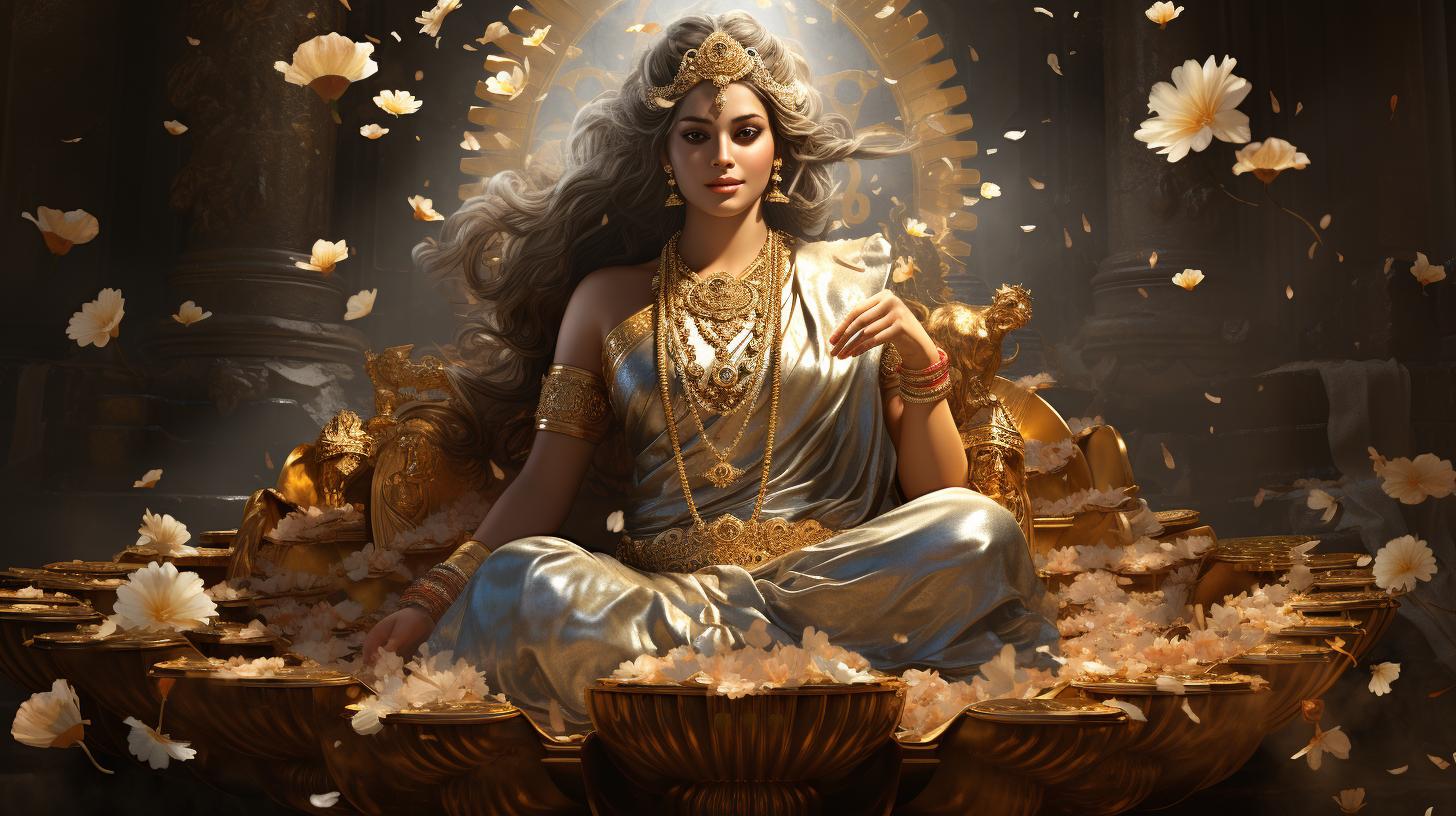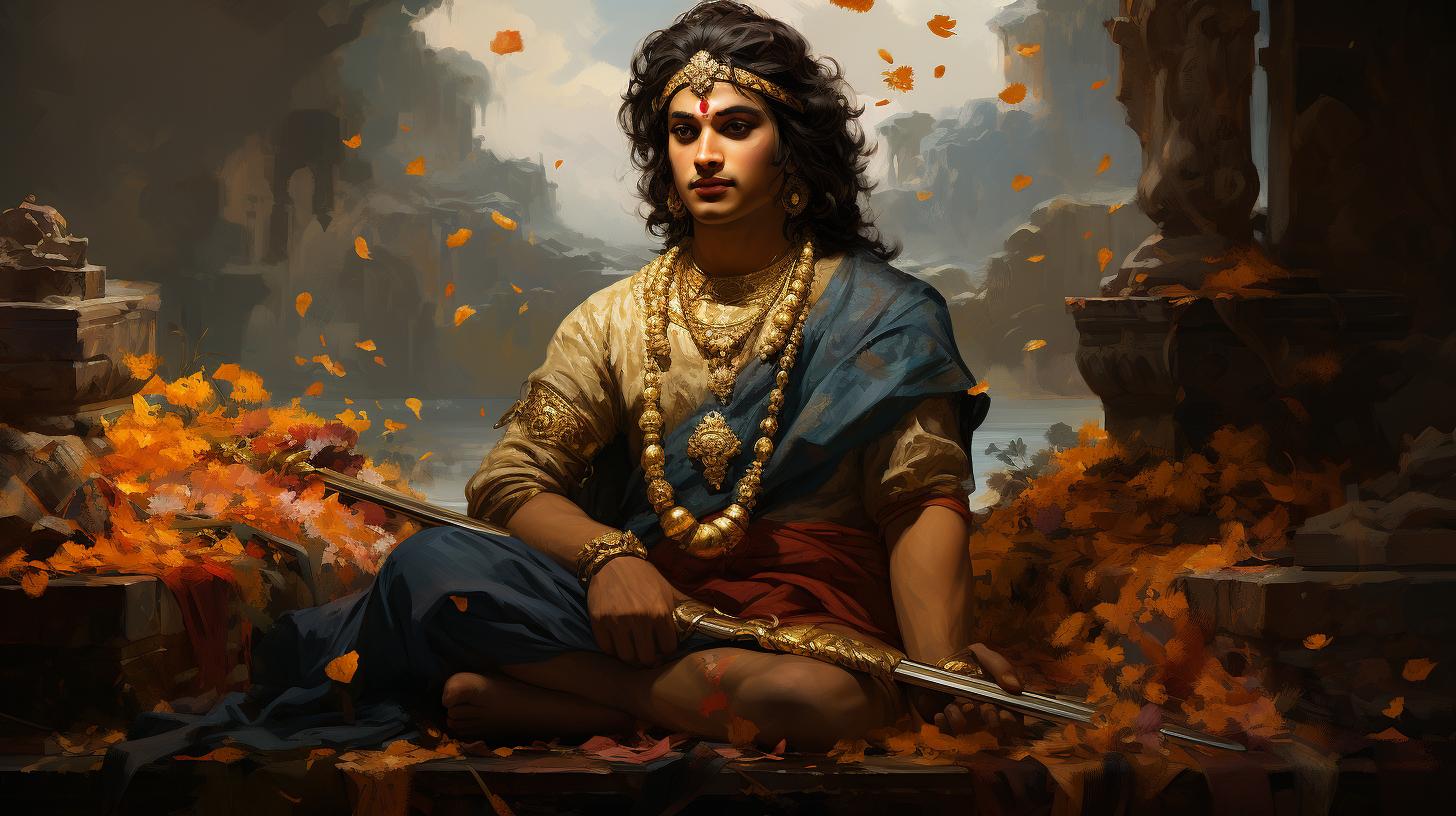Lakshmi Indian Goddess Story: Unveiling the Divine Tale of Lakshmi-Narayana

Lakshmi is a revered goddess in Indian mythology, known as the devoted wife of Vishnu. She emerges from the primordial ocean of milk and resides in Vishnu’s chest.
Lakshmi is often depicted seated or standing on a lotus flower, holding a water vessel and a lotus flower in her hands, symbolizing blessings and abundance. While not having dedicated temples, she is worshipped during the Festival of Lights, Diwali.
Lakshmi’s story, representations in art, and significance in daily life offer valuable lessons for finding balance and prosperity in modern times.
The Origins of Lakshmi
Lakshmi, a revered deity in Hindu mythology, has a fascinating origin story that revolves around her birth from the Ocean of Milk and her divine union with Vishnu. Let’s delve into the mystical tale of Lakshmi’s origins.
Lakshmi’s Birth from the Ocean of Milk
Lakshmi is believed to have emerged from the churning of the cosmic ocean, often referred to as the Ocean of Milk. As the Devas (celestial beings) and Asuras (demons) joined forces to extract the elixir of immortality, various celestial treasures surfaced, including the radiant and enchanting goddess Lakshmi.
This momentous event is symbolic of the cosmic interplay between good and evil, enlightenment and ignorance, and the eternal cycle of creation and destruction. Lakshmi’s emergence from the Ocean of Milk represents the manifestation of abundance, prosperity, and spiritual enlightenment in the world.
The Divine Union of Lakshmi and Vishnu
Lakshmi’s significance escalates when she unites with Vishnu, the supreme god in Hinduism. Together, they form the divine couple known as Lakshmi-Narayana, representing unconditional love, harmony, and the balance of male and female energies.
Legend has it that Lakshmi willingly took birth on Earth to protect Vishnu during his incarnations. She selflessly offered her support, protection, and guidance in various avatars that Vishnu assumed during his earthly sojourns.
This divine partnership beautifully exemplifies the inseparable bond between Lakshmi and Vishnu, embodying the ideals of devotion, companionship, and shared responsibilities.
So, the origins of Lakshmi are intertwined with the cosmic forces, symbolizing her role as the bestower of wealth, prosperity, and spiritual blessings.
Lakshmi in Hindu Mythology
In this section, we explore the various avatars shared by Vishnu and Lakshmi, as well as Lakshmi’s essential role as a protector and provider.
The Many Avatars of Vishnu and Lakshmi
Vishnu, the preserver in Hindu mythology, is believed to descend to Earth in different avatars for the betterment of the world.
With each avatar, Lakshmi assumes a different form to accompany him and fulfill her role as his divine partner. From Sita in the Ramayana to Radha in Krishna’s story, Lakshmi’s presence demonstrates her unwavering loyalty and dedication to Vishnu’s mission.
As Rama’s devoted wife, Sita embodies Lakshmi’s virtues of purity, sacrifice, and selflessness. Her unwavering love and resilience in trying times showcases the strength bestowed upon her by Lakshmi’s grace.
Similarly, Radha’s eternal love for Krishna symbolizes the deep connection between human beings and the divine.
Lakshmi’s Role as a Protector and Provider
Lakshmi is not only a symbol of wealth and prosperity but also a guardian and provider for her devotees. She is believed to protect her devotees from poverty, misfortunes, and negativity.
As the sustainer of life, she brings fortune, abundance, and fertility to those who seek her blessings.
Devotees pray to Lakshmi to receive her grace and ensure prosperity in various aspects of life, including wealth, health, and relationships.
Recognized as the compassionate mother goddess, Lakshmi showers blessings upon her devotees, guiding them towards a path of fulfillment and contentment.
Through her benevolent presence, Lakshmi instills values of gratitude, humility, and generosity in her devotees, encouraging them to share their abundance with others.
She inspires individuals to create a harmonious balance between material prosperity and spiritual well-being.
- She blesses her devotees with financial stability and material wealth.
- She promotes well-being and good health.
- She grants fertility and prosperity in all aspects of life.
- She protects her devotees from poverty and misfortunes.
- She inspires gratitude, humility, and generosity.
Understanding Lakshmi’s significance in Hindu mythology provides a deeper appreciation for her presence in daily life and in various religious ceremonies and festivals.
Symbolism and Representations of Lakshmi
Lakshmi, the revered Hindu goddess, holds deep symbolism as the embodiment of abundance and wealth. Her representation goes beyond material prosperity and encompasses spiritual wealth as well. Let us explore the symbolism associated with Lakshmi in Indian mythology.
Lakshmi as the Goddess of Abundance and Wealth
Worshiping Lakshmi is believed to attract positive energy, success, and financial stability. Devotees seek her blessings to overcome financial hardships and to attain prosperity and well-being in their lives.
Her association with wealth highlights the importance of ethical accumulation and proper utilization of resources in order to create a prosperous and sustainable society.
Lotus Flower: The Sacred Symbol of Lakshmi
The sacred lotus holds great significance in Lakshmi’s iconography. Just as the lotus gracefully emerges from muddy waters, Lakshmi symbolizes the blossoming of divinity amidst the challenges and impurities of life.
The lotus represents purity, spiritual enlightenment, and the cycle of life. Lakshmi is often depicted seated or standing on a fully bloomed lotus flower, signifying her transcendence from the material world and connection with higher consciousness.
Furthermore, the lotus portrays detachment, as its petals remain untouched and unstained by the surrounding water. This teaches us to maintain inner peace and detachment from material desires while actively participating in the world.
The presence of Lakshmi on the lotus signifies that abundance and prosperity can be achieved through purity, spiritual growth, and detachment from ego-driven desires.
Conclusion
In conclusion, Lakshmi’s symbolism and representations in Hindu mythology offer profound insights into the pursuit of abundance and prosperity.
She represents the harmonious balance between material and spiritual wealth, reminding us of the importance of ethical accumulation, proper utilization of resources, and detachment from ego-driven desires.
By understanding the symbolism associated with Lakshmi, we can apply her teachings in our daily lives, seeking not only material prosperity but also the inner transformation that leads to lasting fulfillment and spiritual growth.
Worship and Festivals Celebrating Lakshmi
Worship and festivals dedicated to Lakshmi hold great significance in Hindu culture. Through devotion and rituals, devotees express their reverence and seek the blessings of the goddess of abundance and wealth.
Let’s explore two key aspects of Lakshmi worship: the Diwali festival and the rituals and practices associated with Lakshmi worship.
Diwali: The Festival of Lights and Devotion to Lakshmi
Diwali, also known as Deepavali, is one of the most widely celebrated festivals in Hinduism. It signifies the victory of light over darkness and good over evil. During this five-day festival, devotees illuminate their homes with oil lamps, adorn them with colorful decorations, and burst firecrackers to ward off negativity.
Diwali holds a special place for devotees of Lakshmi as it is believed that she visits households that are clean, well-lit, and welcoming. People invoke Lakshmi’s blessings and prosperity by offering prayers, lighting lamps, and performing aarti (a religious ritual of worship involving light).
Devotees often create intricate rangoli patterns (colorful designs made with colored powders or flowers) at their doorsteps to depict Lakshmi’s footsteps entering their homes. It is believed that Lakshmi’s presence during Diwali brings wealth, fortune, and well-being to their lives.
Rituals and Practices in Lakshmi Worship
Lakshmi worship includes various rituals and practices that vary across different regions and communities. However, common rituals involve creating a sacred space or altar with an image or idol of Lakshmi.
Devotees offer flowers, incense, fruits, sweets, and other auspicious items as a token of their devotion.
During prayers, mantras and hymns dedicated to Lakshmi, such as the Shri Sukta, are recited to invoke her blessings.
Some devotees observe fasting on specific auspicious days associated with Lakshmi, seeking her grace and divine blessings.
Additionally, performing acts of charity and helping those in need are considered integral parts of Lakshmi worship.
By sharing one’s wealth and abundance with others, devotees express gratitude for the blessings received and show compassion towards the less fortunate.
Overall, devotees engage in these rituals and practices with love, devotion, and reverence, seeking Lakshmi’s blessings for a joyous and prosperous life.
- Significance of Diwali in Hindu culture
- Devotees invoking Lakshmi’s blessings
- Lamps, decorations, and rangoli patterns
- Rituals and practices of Lakshmi worship
- Offerings, mantras, and hymns
- Observing fasts and acts of charity
Lakshmi in Art and Iconography
Lakshmi, as a revered goddess in Hindu mythology, is prominently depicted in various forms of Indian art.
Artists have beautifully captured her divine essence and symbolic representations, showcasing her significance in spiritual and daily life.
Depictions of Lakshmi in Indian Art
In Indian art, Lakshmi is often portrayed with grace and elegance, reflecting her role as the Goddess of Abundance and Wealth. She is commonly shown standing or seated on a blooming lotus flower, symbolizing purity and enlightenment.
Lakshmi’s four hands hold symbolic objects, such as a water vessel representing purification, a lotus representing spiritual growth, and sometimes gold coins representing prosperity.
The artists masterfully capture the gentle expression on Lakshmi’s face, radiating compassion and serenity.
Ornate jewelry adorns her form, enhancing her divine aura. Her presence in Indian art serves as a constant reminder of the importance of embracing abundance and seeking spiritual enlightenment.
Cultural Influence: Lakshmi in Cambodian, Cham, and Javanese Art
The influence of Lakshmi extends beyond India, reaching Southeast Asian cultures such as Cambodia, Cham, and Java.
In Cambodian art, Lakshmi is known as Lokeshvara, a female form of Avalokiteshvara, the Bodhisattva of Compassion. She is depicted with multiple arms, each holding symbolic objects associated with both Hindu and Buddhist traditions, signifying her role as a unifying deity.
In Cham art, Lakshmi is revered as Po Nagar, the mother goddess of the Cham people. She is depicted standing on a lotus, holding objects like a mirror and a mace, representing her protective and nurturing qualities.
Javanese art showcases Lakshmi’s influence as Sri, the goddess of wealth and fortune. She is depicted gracefully adorned, standing or sitting on a lotus throne, holding a water vessel and a lotus flower.
Her depiction in Javanese art represents the importance of prosperity and the pursuit of a harmonious life.
These cross-cultural representations of Lakshmi exemplify the wide-ranging impact she has had on art and spirituality across different regions, showcasing her timeless significance and universal appeal.
- Indian art beautifully captures Lakshmi’s divine essence, portraying her standing or seated on a lotus flower.
- Artistic depictions highlight Lakshmi’s symbolic objects, such as a water vessel, a lotus, and gold coins.
- Lakshmi’s presence in Indian art serves as a reminder to embrace abundance and seek spiritual growth.
- In Cambodia, Cham, and Java, Lakshmi’s influence can be seen in their art and traditions.
- These cultural representations showcase Lakshmi’s significance across different regions and belief systems.
The Significance of Lakshmi in Spiritual and Daily Life
Lakshmi, the revered goddess of wealth and abundance, holds immense significance in both spiritual and daily aspects of life.
Her blessings and teachings are believed to guide individuals towards attaining prosperity and finding harmony within themselves and their surroundings.
Attaining Prosperity: Lakshmi’s Blessings and Teachings
Lakshmi symbolizes not just material wealth, but also spiritual prosperity. Her blessings are sought after by devotees who aspire to lead a fulfilled and abundant life. Lakshmi teaches us the importance of gratitude, generosity, and humility in attracting prosperity into our lives.
Through her grace, devotees are encouraged to cultivate positive virtues and engage in righteous actions, ultimately leading to a life of abundance and fulfillment.
Her teachings emphasize the significance of hard work, dedication, and perseverance to achieve success. Lakshmi reminds us that prosperity is not solely based on external riches, but also on the qualities of inner abundance and contentment.
By striving to embody her virtues and learning from her teachings, individuals can cultivate a prosperous mindset and attract positive energy into their lives.
Lakshmi’s Role in Yoga and Chakra Balance
Lakshmi’s presence is deeply intertwined with the practice of yoga and the balance of energy centers, known as chakras, within the body. In yogic philosophy, she represents the energy of the Manipura Chakra, which is associated with personal power, confidence, and abundance.
By connecting with Lakshmi’s energy, individuals can activate and harmonize their Manipura Chakra, thus enhancing their self-esteem, vitality, and ability to manifest abundance in life.
Yoga practitioners often invoke Lakshmi’s energy through specific asanas (poses) and breathwork to purify and balance their energy centers. By aligning with Lakshmi’s energy, they seek to enhance their spiritual growth, awaken their inner potential, and cultivate a deeper connection with abundance on all levels – physical, emotional, mental, and spiritual.
Lessons from Lakshmi’s Story for Modern Times
In the ancient tale of Lakshmi, there are valuable lessons that can be applied to our lives in the modern world. The story of this revered goddess provides insights into finding a balance between material and spiritual wealth, and how her teachings can enhance both our personal and professional lives.
Finding Balance Between Material and Spiritual Wealth
Lakshmi’s story emphasizes the importance of finding harmony between material and spiritual aspects of life. While she is known as the goddess of abundance and wealth, her significance goes beyond mere material possessions.
It teaches us that true prosperity lies in maintaining a balance between material comfort and spiritual growth.
In today’s fast-paced world, it is easy to get caught up in the pursuit of material wealth, often neglecting our spiritual well-being.
Lakshmi’s story reminds us of the need to nurture both aspects of our lives. By finding the right balance, we can experience true abundance and fulfillment.
Moreover, the story of Lakshmi encourages us to cultivate gratitude for the blessings in our lives.
It serves as a reminder that wealth and abundance should not be taken for granted, and instead, we should appreciate and share our resources with those in need.
Applying Lakshmi’s Teachings to Enhance Personal and Professional Life
The wisdom derived from Lakshmi’s story has practical applications in both our personal and professional spheres.
Cultivating Prosperity Consciousness:
- Developing a positive mindset helps attract opportunities for growth and success.
- By recognizing and appreciating our own worth, we can create a foundation for prosperity.
- Nurturing self-confidence and self-belief can empower us to achieve our goals.
Embracing Abundance Mentality:
- Adopting a mindset of abundance allows us to see possibilities and embrace opportunities.
- Letting go of scarcity mindset helps in overcoming fear and limitations in our lives.
- By focusing on abundance, we open ourselves up to receive blessings and opportunities.
Balancing Work and Well-being:
- Prioritizing self-care and maintaining a healthy work-life balance contributes to overall well-being.
- Understanding that success does not solely depend on professional achievements, but also on personal satisfaction and contentment.
- Avoiding burnout and fostering a harmonious equilibrium between career and personal life.
In conclusion, exploring the lessons from Lakshmi’s story empowers us to find balance between material and spiritual wealth, and apply her teachings to enhance our personal and professional lives.
By incorporating these insights into our daily practices, we can strive towards a prosperous and fulfilling existence.
..




















